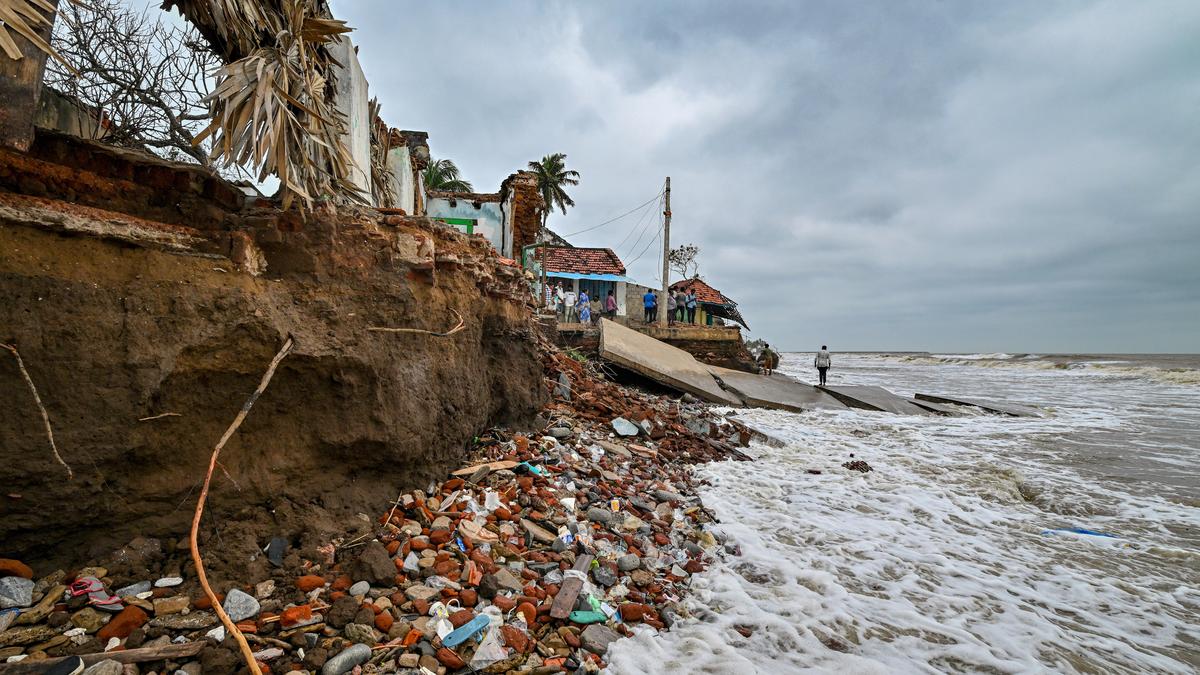Copyright thehindu

Severe cylonic storm Montha left a trail of destruction in Andhra Pradesh, leaving two persons dead and inundating agricultural crops across 87,000 hectares. It also damaged roads, bridges and culverts, and uprooted trees, officials said after a preliminary assessment. The severe cyclonic storm crossed the Andhra Pradesh and Yanam coasts between 11:30 p.m. on Tuesday (October 28, 2025) and 12:30 a.m. on Wednesday (October 29), close to Narsapuram in Andhra Pradesh, the India Meteorological Department said. Wind speeds touched 90 kmph near the Machilipatnam coast as the storm crossed the coast. It gradually weakened into a cyclonic storm by 2:30 a.m. and then into a deep depression by 8:30 a.m. on Wednesday (October 29), it added. Also Read: Cyclone Montha Updates on October 29, 2025 At 5:30 p.m., the deep depression over north Andhra Pradesh, south Odisha, south Chhattisgarh and northeast Telangana weakened into a depression over south Chhattisgarh. It is likely to move northwards and weaken into a well-marked low-pressure area during the next 12 hours, the bulletin at 8:30 p.m. said. Cyclone impact Two districts, SPSR Nellore and Prakasam, received extremely heavy overnight rain. Ongole in Prakasam district received 25 cm; Chimakurthi (Prakasam) 24 cm, Kandukur and Kavali (SPSR Nellore) 22 cm; and Addanki (Bapatla) recorded 19 cm. In total, 27 stations in the State, most of them in Prakasam, SPSR Nellore, and Bapatla, recorded 10 cm and more during the 24-hour period ending at 8 a.m. on Wednesday.(October 29) According to preliminary assessment, crops were damaged on 87,000 hectares across 304 mandals and 1,825 villages. Over 59,000 hectares of paddy, cotton, maize, and black gram fields were submerged, resulting in severe losses to 78,796 farmers. Several roads, 14 bridges, and multiple culverts were damaged. About 2,294 km of the Roads and Buildings department roads were affected, with losses estimated at ₹1,424 crore. The Rural Water Supply department sustained losses of about ₹36 crore, while irrigation works worth ₹16.45 crore were affected. The Narsapuram coast, where the landfall happened, saw no major damage. West Godavari Collector Chadalavada Nagarani said, “The Narsapuram coast did not witness any major loss. However, 268 trees, mostly coconut, collapsed. Nearly 100 more trees are believed to have uprooted. The National Disaster Response Force personnel are removing those trees from the roads”. However, Uppada, a famous weaver town on the Kakinada coast, reported heavy losses. As many as 61 houses were damaged. Houses belonging to fisherfolk were damaged by giant waves. Kakinada Collector S. Shan Mohan said: “No human loss has been reported along the Kakinada coast. Crops on more than 5,500 acres have been damaged and 51 km of roads have also been damaged”. At the Kumbabhishekam fish landing point near Kakinada Deepsea port, Gaddepalli Sairam, a fisherman hailing from Dummulapeta is feared to have drowned in the sea. The NDRF personnel have intensified the search in the sea. CM reviews measures Chief Minister N. Chandrababu Naidu took stock of the cyclone impact at Odalarevu in Allavaram mandal of Dr. B.R. Ambedkar Konaseema district, Bapatla and Machilipatnam during an aerial survey. Pointing out that Prakasam and Nellore districts bore the brunt of heavy rains, the Chief Minister said damage to crops and assets has been reported in every coastal district. The loss is being enumerated. Referring to compensation to the cyclone victims, Mr. Naidu said the fisherfolk who failed to undertake fishing activities and handloom weavers would be given 50 kg of rice, apart from essential commodities. They will also be paid ₹3,000 per family. The other affected people will get 25 kgs of rice. Pointing out that more than 1.8 lakh people were evacuated to 2,200 relief camps to minimise loss of life, the Chief Minister said: “Our strategy of evacuating people from the vulnerable areas helped minimise loss of life and property. Past experiences of dealing with natural calamities and technology helped us design a robust preparedness plan,” Mr. Naidu told the media at a relief camp at Odalarevu.



